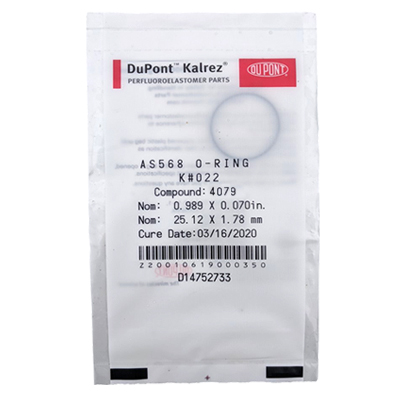The semiconductor industry is a specialty market that requires seals to work in extreme chemical and temperature environments - and these seals must block materials from entering the fluid stream.
There are several different ways for seals to accomplish this task, but the first consideration is the operating characteristics.
Operating Characteristics of Seals for the Semiconductor Industry
For static seals where no relative motion exists, the use of perfluoroelastomers, or FFKM rubber, is considered a first consideration.
Gallagher Fluid Seals is a designated distributor of Dupont™ Kalrez ®. Kalrez parts have excellent chemical and thermal stability, and have been specially formulated and processed to meet the unique requirements of wafer processing environments.
DuPont offers molded O-rings and custom seals using a series of specialty products and ultrapure processing for the semiconductor industry.
Ultrapure processing is standard for all semiconductor product grades and must be specified for Kalrez 6375UP and 7075UP.
The Role of PTFE in Semiconductor Seals
For dynamic seal applications where a consideration is wear and friction in these same operating conditions, Gallagher's partner Eclipse designs and manufactures spring and rubber energized seals made from materials such as Polytetrafluoroethylene PTFE, (Teflon®) or Ultra High Molecular Weight Polyethylene.
These seals are typically machined cross sections, and are energized by metallic springs or rubber elastomers.
PTFE is essentially inert to almost any chemical, and a metal spring can be selected from the accepted metals used in other areas of the equipment — typically a 300 series spring steel.
If the seal is rubber energized, the use of a Perfluoroelastomer such as Kalrez may be used for its excellent chemical and temperature compatibility.
The use of these polymers allows for dynamic motion to occur without abrading the mating surface. These polymers can resist contamination in the fluid stream, while keeping friction to a minimum and operating in varying temperatures to satisfy the application.
Dynamic seals can operate in reciprocating, oscillatory and rotary motion. Due to their relative coefficient of friction compared to elastomeric seals, these polymers can dramatically reduce the amount of heat induced by the dynamic motion into the system.
These materials are not limited to round shapes. They can be machined into virtually any profile to accommodate the application.
Specialty Design Elements for Semiconductor Seals
When pressures exceed the mechanical strength of these standard polymers, Eclipse can build backup ring combinations to handle pressures in excess of 100K PSI.
When pressures go negative or vacuum, Eclipse is capable of building sealing systems that are capable of sealing to extreme vacuum, and continue to function as dynamic seals.
This is accomplished with our super finish process for polymers, in combination with the application hardware and finishing of the mating surface for the dynamic application.
For boundary seals for electronic enclosures, Eclipse can design seals or protection devices to keep the outside environment out and retain fluids from getting out of the electronic device.
Our partners at Eclipse have designed both Polymer enclosure seals that operate in severe glove box or electronic enclosures to ensure product within the enclosure stays there, and the outside environment stays out.
When designing with the harshest of chemicals and operating at temperatures that can swing from -400 degrees Fahrenheit to an excess of 500 degrees, the use of a polymers such as PTFE and elastomeric materials such as FFKM (Kalrez) provide for long term solutions that will keep your production equipment up and running longer and your PM cycles to a minimum. This reduces overall downtime, improving run time and making your operation more profitable.
The original article can be found on Eclipse's website here.
Gallagher Fluid Seals is a preferred partner of Eclipse Engineering.

